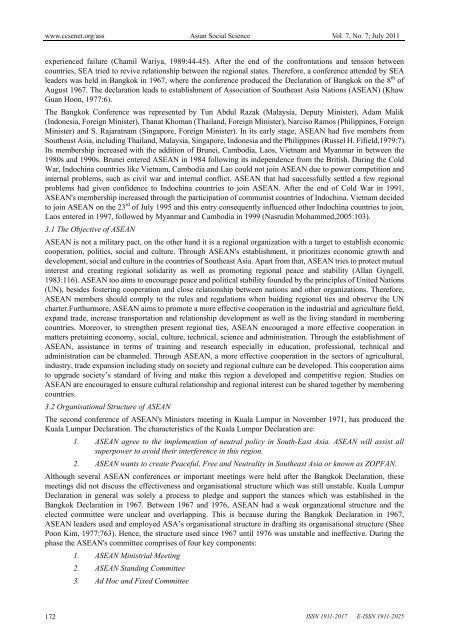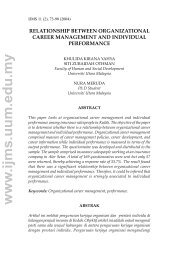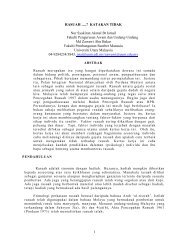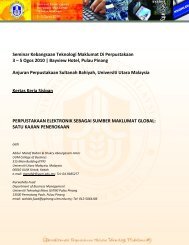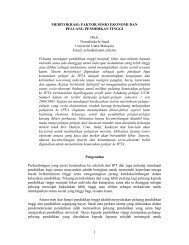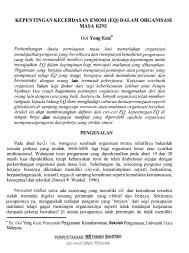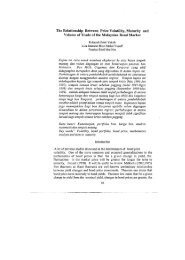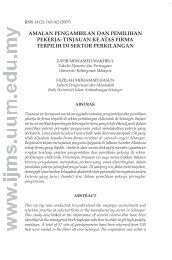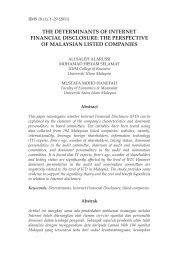The Development of ASEAN from Historical Approach
The Development of ASEAN from Historical Approach
The Development of ASEAN from Historical Approach
You also want an ePaper? Increase the reach of your titles
YUMPU automatically turns print PDFs into web optimized ePapers that Google loves.
www.ccsenet.org/ass Asian Social Science Vol. 7, No. 7; July 2011<br />
experienced failure (Chamil Wariya, 1989:44-45). After the end <strong>of</strong> the confrontations and tension between<br />
countries, SEA tried to revive relationship between the regional states. <strong>The</strong>refore, a conference attended by SEA<br />
leaders was held in Bangkok in 1967, where the conference produced the Declaration <strong>of</strong> Bangkok on the 8 th <strong>of</strong><br />
August 1967. <strong>The</strong> declaration leads to establishment <strong>of</strong> Association <strong>of</strong> Southeast Asia Nations (<strong>ASEAN</strong>) (Khaw<br />
Guan Hoon, 1977:6).<br />
<strong>The</strong> Bangkok Conference was represented by Tun Abdul Razak (Malaysia, Deputy Minister), Adam Malik<br />
(Indonesia, Foreign Minister), Thanat Khoman (Thailand, Foreign Minister), Narciso Ramos (Philippines, Foreign<br />
Minister) and S. Rajaratnam (Singapore, Foreign Minister). In its early stage, <strong>ASEAN</strong> had five members <strong>from</strong><br />
Southeast Asia, including Thailand, Malaysia, Singapore, Indonesia and the Philippines (Russel H. Fifield,1979:7).<br />
Its membership increased with the addition <strong>of</strong> Brunei, Cambodia, Laos, Vietnam and Myanmar in between the<br />
1980s and 1990s. Brunei entered <strong>ASEAN</strong> in 1984 following its independence <strong>from</strong> the British. During the Cold<br />
War, Indochina countries like Vietnam, Cambodia and Lao could not join <strong>ASEAN</strong> due to power competition and<br />
internal problems, such as civil war and internal conflict. <strong>ASEAN</strong> that had successfully settled a few regional<br />
problems had given confidence to Indochina countries to join <strong>ASEAN</strong>. After the end <strong>of</strong> Cold War in 1991,<br />
<strong>ASEAN</strong>'s membership increased through the participation <strong>of</strong> communist countries <strong>of</strong> Indochina. Vietnam decided<br />
to join <strong>ASEAN</strong> on the 23 rd <strong>of</strong> July 1995 and this entry consequently influenced other Indochina countries to join,<br />
Laos entered in 1997, followed by Myanmar and Cambodia in 1999 (Nasrudin Mohammed,2005:103).<br />
3.1 <strong>The</strong> Objective <strong>of</strong> <strong>ASEAN</strong><br />
<strong>ASEAN</strong> is not a military pact, on the other hand it is a regional organization with a target to establish economic<br />
cooperation, politics, social and culture. Through <strong>ASEAN</strong>'s establishment, it prioritizes economic growth and<br />
development, social and culture in the countries <strong>of</strong> Southeast Asia. Apart <strong>from</strong> that, <strong>ASEAN</strong> tries to protect mutual<br />
interest and creating regional solidarity as well as promoting regional peace and stability (Allan Gyngell,<br />
1983:116). <strong>ASEAN</strong> too aims to encourage peace and political stability founded by the principles <strong>of</strong> United Nations<br />
(UN), besides fostering cooperation and close relationship between nations and other organizations. <strong>The</strong>refore,<br />
<strong>ASEAN</strong> members should comply to the rules and regulations when buiding regional ties and observe the UN<br />
charter.Furthurmore, <strong>ASEAN</strong> aims to promote a more effective cooperation in the industrial and agriculture field,<br />
expand trade, increase transportation and relationship development as well as the living standard in membering<br />
countries. Moreover, to strengthen present regional ties, <strong>ASEAN</strong> encouraged a more effective cooperation in<br />
matters pretaining economy, social, culture, technical, science and administration. Through the establishment <strong>of</strong><br />
<strong>ASEAN</strong>, assistance in terms <strong>of</strong> training and research especially in education, pr<strong>of</strong>essional, technical and<br />
administration can be channeled. Through <strong>ASEAN</strong>, a more effective cooperation in the sectors <strong>of</strong> agricultural,<br />
industry, trade expansion including study on society and regional culture can be developed. This cooperation aims<br />
to upgrade society’s standard <strong>of</strong> living and make this region a developed and competitive region. Studies on<br />
<strong>ASEAN</strong> are encouraged to ensure cultural relationship and regional interest can be shared together by membering<br />
countries.<br />
3.2 Organisational Structure <strong>of</strong> <strong>ASEAN</strong><br />
<strong>The</strong> second conference <strong>of</strong> <strong>ASEAN</strong>'s Ministers meeting in Kuala Lumpur in November 1971, has produced the<br />
Kuala Lumpur Declaration. <strong>The</strong> characteristics <strong>of</strong> the Kuala Lumpur Declaration are:<br />
1. <strong>ASEAN</strong> agree to the implemention <strong>of</strong> neutral policy in South-East Asia. <strong>ASEAN</strong> will assist all<br />
superpower to avoid their interference in this region.<br />
2. <strong>ASEAN</strong> wants to create Peaceful, Free and Neutrality in Southeast Asia or known as ZOPFAN.<br />
Although several <strong>ASEAN</strong> conferences or important meetings were held after the Bangkok Declaration, these<br />
meetings did not discuss the effectiveness and organisational structure which was still unstable. Kuala Lumpur<br />
Declaration in general was solely a process to pledge and support the stances which was established in the<br />
Bangkok Declaration in 1967. Between 1967 and 1976, <strong>ASEAN</strong> had a weak organzational structure and the<br />
elected committee were unclear and overlapping. This is because during the Bangkok Declaration in 1967,<br />
<strong>ASEAN</strong> leaders used and employed ASA’s organisational structure in drafting its organisational structure (Shee<br />
Poon Kim, 1977:763). Hence, the structure used since 1967 until 1976 was unstable and ineffective. During the<br />
phase the <strong>ASEAN</strong>'s committee comprises <strong>of</strong> four key components:<br />
1. <strong>ASEAN</strong> Ministrial Meeting<br />
2. <strong>ASEAN</strong> Standing Committee<br />
3. Ad Hoc and Fixed Committee<br />
172<br />
ISSN 1911-2017 E-ISSN 1911-2025


